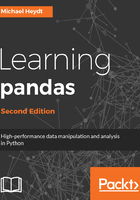
上QQ阅读APP看书,第一时间看更新
Heads, tails, and takes
pandas provides the .head() and .tail() methods to examine the first (head) or last (tail) few rows in a Series. By default, these return the first or last five rows, but this can be changed using the n parameter.
Let's examine the usage given the following Series:

The following retrieves the first five rows:

The number of items can be changed using the n parameter (or just by specifying the number):

.tail() returns the last five rows:

It works similarly when specifying a number other than 5:

The .take() method returns the rows in a series at the specified integer position:
